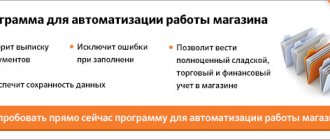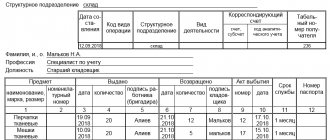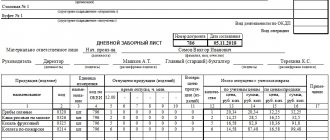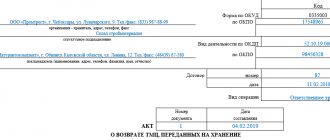How and why a demand invoice is drawn up, form M-11
What is a demand invoice M-11?
In the article we will look at why a document is needed, on what basis it is drawn up, how it is drawn up, and how long it is stored. All sample forms mentioned in the article can be downloaded. ConsultantPlus FREE for 3 days Get access The demand invoice (form M-11) is an internal document of the organization - it is not transferred to either the buyer or the supplier. All movements of materials in the organization: between departments, from employee to employee - are accompanied by the execution of this document.
IMPORTANT! Unified forms of primary accounting documents approved by Resolution of the State Statistics Committee of October 30, 1997 No. 71a are not mandatory, based on the requirements of Law No. 402-FZ. An organization can consolidate the forms of primary accounting documents in its accounting policies. The exception is unified forms that are mandatory for use on the basis of federal laws and regulations.
Unified forms for public sector organizations are defined in Order of the Ministry of Finance dated March 30, 2015 No. 52n, which specifies the form of the demand invoice (OKUD 0504204). This means that public sector organizations must only use Form 0504204.
IMPORTANT! If the organization provides restrictions on the supply of goods and materials, then for this purpose a form of limit-fence cards M-8 is provided, which can be downloaded at the bottom of the article. M-11 contains the following information:
- name of goods and materials;
- sender (structural unit or department, OKVED type of activity);
- recipient (structural unit or department, OKVED);
- accounting account (sub-account) (sender, recipient);
- quantity of inventory items;
- price.
Transfer of inventory items can be carried out in the following cases:
- return of balances to the warehouse (unused in the production process of goods and materials);
- return to the warehouse of defective products (production waste);
- issuing materials from the warehouse to the responsible person;
- moving between warehouses, etc.
Fill out M-11 online
Fill out the M-11 invoice online!
Register in the MoySklad online service - you will be able to: completely free of charge:
- Fill out and print the document online (this is very convenient)
- Download the required form in Excel or Word
Read more Russian Post write a complaint to the hotline
Connect the M-11 template, then select Products - Movements and specify the desired product. The system will generate the document automatically: enter the number and date, and calculate the balance of inventory items in the warehouse. You can print the completed form in one click.
Information about the company, products, warehouses is saved in the system - it does not need to be re-entered into the document each time. This is convenient if you regularly ship inventory items from a warehouse, for example, transfer stationery to the office.
You can also download a blank demand invoice form (form M11) in excel and fill it out yourself.
Form M-11: what is it used for?
In accordance with the Instructions for the use and completion of forms (approved by Resolution of the State Statistics Committee of October 30, 1997 No. 71a), the M-11 form is used to record the movement of material assets within the organization between structural divisions or materially responsible persons (MOL). Also, the M-11 consignment note can be used to document operations for the delivery of unspent materials to a warehouse from production, as well as the delivery of waste and scrap.
Let us remind you that unified forms of primary accounting documentation (including form No. M-11) are not mandatory for use from 01/01/2013 (Information of the Ministry of Finance No. PZ-10/2012). Therefore, the organization itself decides whether to use the M-11 form and for what purposes. The fact of application of the invoice requirement in a unified form, as well as cases of its use, is established by the organization in its Accounting Policy for accounting purposes.
If a demand invoice is used to document the consumption of materials, this primary document will be the basis for reflecting the write-off of materials to the production cost accounts (20 “Main production”, 25 “General production expenses”, 26 “General expenses”, etc.), as well as to the account for accounting expenses for sales (account 44 of the same name according to the Chart of Accounts) (Order of the Ministry of Finance dated October 31, 2000 No. 94n).
Standard intersectoral form M-11: sample filling
Form No. M-11 is usually drawn up in 2 copies by the materially responsible person of the structural unit handing over material assets. For such a division, the demand invoice will be the basis for writing off valuables, and for the receiving warehouse - the basis for their receipt. Form No. M-11 is signed by the MOL of the deliverer and the recipient, and then transferred to the accounting department to record the movement of materials.
For form M-11 “Demand invoice” we provide a sample of filling out for the case when such a form is used in a trade organization to account for the write-off of office supplies.
Many large companies include several divisions. Often there is a need to transfer one or another value or return unused material to another department. To have a clear idea of where certain material assets are located, any movement of inventory items should be documented.
Form M-11 (request-invoice) is a document that is used to record the movement of inventory items within the company. The company has the right to develop this document independently, including the required details, and the requirement-invoice M-11 will be used as a sample for completion.
The standard intersectoral form M-11 was approved by Decree of the State Statistics Committee of the Russian Federation dated October 30, 1997 No. 71a.
When is M-11 compiled?
Let's consider the movement of goods within the organization.
Inventory and materials arrive at the warehouse, and the storekeeper draws up a document reflecting the receipt: for example, receipt order M-4 (form according to OKUD 0315003). The data is also reflected in the materials accounting card, for example, in form M-17 (OKUD 0315008) (forms M-4 and M-17 can be downloaded below).
The goods are then stored in the warehouse until shipment. The warehouseman can ship goods to both contractors (suppliers, customers) and internal users (employees, owners, founders).
If there is a need to ship goods within the company, then in this case an M-11 invoice is issued. The basis for issuing a demand invoice is the request for material assets located in the warehouse.
The invoice should be printed in three copies:
- one is kept by the sender;
- the second is transferred to the accounting department;
- the third copy is in stock.
In what cases is the M-11 invoice requirement applied?
In addition to moving inventory items between departments or financially responsible persons, the invoice is also used in other cases. Using form M-11, you can arrange the release from the warehouse of various equipment or tools to perform work. For example, a company needs to give employees office supplies that are stored in a warehouse. Stationery supplies are transferred to a specific structural unit and then handed over to employees. In this case, the company can use Form M-11.
It can also be used to process the return to the warehouse of materials that were put into operation, but were not completely consumed. It is worth paying attention that if materials are returned by a division of an organization that is territorially separate from it, it is not the M-11 invoice that is issued, but the M-15 form.
The unified form M-11 is also used to transfer finished products or parts of products to the warehouse that will be used as material for another type of production.
In addition, form M-11 serves as the basis for reflecting the transfer of returnable waste to the warehouse from the organization’s production workshop. Waste that is generated during the production process in the organization's divisions is collected in the prescribed manner and delivered to warehouses. Such transfer must be completed as follows: requirements - invoice in form M-11 and fill out the form, indicating the names and quantities of waste.
What should you do if, during the production of products for sale by the company, a defect is discovered that cannot be eliminated? Defective goods that cannot be corrected can be sold or used in some way in your business. Therefore, the company has the right to receive them into the warehouse at the price of possible use (if a decision is made to use defective goods in business). To do this, it is necessary to issue an invoice for the internal movement of defective goods to the warehouse in the M-11 form.
Who should sign the demand invoice v 11 allowed
Request invoice form M-11 with additional signatures “Through whom”, “Allowed” and “Requested”.
https://youtu.be/j5TexWgriBU
Example of filling out Request invoice M-11 is filled out by the person who issues the goods and materials. Drawing up two copies is a mandatory requirement, since only originals of primary documents should be used in the accounting of each individual division.
The employee involved in the preparation of the document bears financial responsibility for the fact that the information entered in the document is reliable, as well as for the consequences that arose as a result of the indication of unreliable, inaccurate or incomplete information specified in the invoice.
At the same time, employees of the enterprise, institution (heads of workshops, foremen, timekeepers, employees of economic planning, financial departments, labor and wages departments, supplies, storekeepers, accountable persons, accounting employees and others) create and submit documents related to their field activities, according to the document flow schedule. For this purpose, each performer is given an extract from the schedule.
Since the demand invoice is used within the company, it can include several different items and names of goods and materials, except in cases where special restrictions are imposed on the consumption of some inventory items in the form of limits.
Formally, the demand invoice will lose force if the information is incomplete, so all fields must be filled out. And it is imperative that they are filled out correctly. Marks, corrections, strikethroughs, unreadable text, etc. are not allowed on the invoice. If erroneous or inaccurate data is entered, a new copy is filled in.
We invite you to read: Employment contract for stoker and watchman
N 85n “On approval of the program for the development of federal accounting standards for 2020 - 2020.” and on invalidating the order of the Ministry of Finance of the Russian Federation dated May 23, 2020.
Accounting forms - demand invoice, standard form M-11. They are used to record the movement of material assets within the organization, for the delivery of waste and scrap. The forms are printed on A5 offset paper. The set contains 100 pieces, glued together in the form of a book.
Packed in shrink film.
In your wording, the meaning of the question is not entirely clear. TN is the basis for the legal movement of goods and materials from the sender to the recipient. Moreover, these two entities can be either different, for example, legal entities, or one, for example, between branches - I believe that the divisions have different accountable inventory records.
From which it follows that although the details “Requested” and “Allowed” are mandatory to fill out, the procedure for filling them out by the statistical authorities that developed the specified primary document is not explained. According to clause 11 of the Guidelines for accounting of inventories, approved by Order of the Ministry of Finance of the Russian Federation No. 119n dated December 28.
[/attention]
At the same time, the primary accounting documents must be properly prepared, with all the necessary details filled in, and have the appropriate signatures.
https://youtu.be/Z3CQq3z8IFg
As a rule, the form is filled out by the financially responsible employee. Purpose of the document Any business transactions of the organization must be confirmed by primary accounting documentation. The movement of valuables within the organization is taken into account using the invoice requirement.
Form M-11 is applicable in such cases as: Transfer to warehouse storage of finished products, which will subsequently be used for other production Return to the warehouse of materials previously issued for operational use, but completely unused Transfer to the warehouse of production waste Which are not subject to disposal, since they can be used as secondary raw materials for other production processes Issuance of various equipment from the warehouse As an example, issuance of special uniforms to employees.
It is important for an organization to monitor the internal movement of material assets. The requirement-invoice M-11 helps to carry out expenditure and receipt transactions on inventory items, as well as determine who is responsible for the safety of valuables. The fact of movement of material assets within the organization must be documented.
This is the only way to ensure internal accounting procedures.
- Basic information
- How a demand invoice is formed using form M-11
Convenient for documenting the internal movement of goods and materials is the requirement-invoice form M-11. How to draw up a document correctly? Most enterprises, with the exception of small organizations, include several divisions. Individual employees of each department are responsible for the safety of material assets.
External printed form for configuration 1C: Accounting 8, edition 2.0 (Basic and PROF). Totals by quantity and amount have been added to the footer of the materials table.
We suggest you read: Can I ignore my former boss’s threats of forced eviction?
The full names and positions of the responsible persons are automatically filled in the fields: “Through whom,” “Requested,” “Allowed,” “Released” and “Received.” Data about the specified responsible persons is taken from the additional properties of the corresponding organization. If the properties of the organization “Requested” and “Received” are not filled in, then the data is taken from the responsible person specified at the warehouse in the invoice request.
MSWord The invoice in two copies is prepared by the financially responsible person of the structural unit handing over material assets. One copy serves as the basis for the depositing warehouse to write off valuables, and the second copy serves as the basis for the receiving warehouse for posting valuables. The same invoices document operations for the delivery of unspent materials from production to a warehouse or storeroom, if they were previously received upon request, as well as the delivery of waste and scrap. The invoice is signed by the financially responsible persons of the deliverer and the recipient, respectively, and submitted to the accounting department to record the movement of materials.
It needs to display:
- corresponding account (account, subaccount, analytical accounting code);
- name of materials and their number according to the nomenclature;
- unit of measurement (code, name);
- quantity (requested and issued);
- price of one unit;
- total amount excluding VAT;
- serial number in warehouse accounting.
Having filled one side, you can move on to the second. There is also a table here, which is a continuation of the previous one. It is necessary when several types of inventory items are sold at once, since each item is displayed on a separate line. After completing the document and entering all the necessary data, all that remains is to certify the form.
https://youtu.be/CToEssYWwfc
The step-by-step instructions for filling out the invoice request in form M-11 are as follows: Fill in the codes corresponding to the classifier Enter the registration number of the document Numbering is carried out sequentially from the beginning of the reporting year Write the name of the organization - The date of compilation is the date of the transaction for the transfer of goods and materials The transaction code can be filled in When used organization of the coding system or put a dash. The sender is indicated by the structural unit transferring the value, and the type of its main activity. The recipient is indicated by the receiving unit. With its type of activity displayed. In the column of the corresponding account, write the debit of the synthetic account Which corresponds with the inventory account.
Requirement: invoice form M-11. Filling example
The document is drawn up in two copies. One copy remains in the warehouse and serves as the basis for writing off valuables, and the second copy is sent to the receiving party and serves for the receipt of valuables.
In the header of the invoice request in form M-11, you must fill in the document number, company name, OKPO code. The following contains a table of 9 columns:
- Date of preparation of the invoice request;
- Operation type code;
- Sender's structural unit;
- Type of activity of the sender;
- Recipient's department;
- Type of activity of the recipient;
- Corresponding account: account, sub-account;
- Corresponding account: analytical accounting code;
- Accounting unit of output of products (works or services).
Under the table in the invoice request, fields are provided for filling in the following information: through whom the valuables were sent, information about the person who requested the material assets, and the person who authorized the transfer of valuables.
Further, in the invoice request in form M-11, another table is provided. It contains 11 columns:
- Information about the corresponding account: account, subaccount;
- Information about the corresponding account: analytical accounting code;
- Names of material assets;
- Nomenclature number of material assets;
- Unit code;
- Name of the unit of measurement;
- The amount of material assets that was requested;
- The amount of material assets that were actually released;
- Price;
- Price excluding VAT;
- Serial number of inventory items according to the warehouse file cabinet.
Who signs the demand invoice on form M-11? The warehouse employee who released the inventory and the responsible person who received the inventory. Next, the standard interindustry form N M-11 is transferred to the accounting department.
Requirements for document preparation
A person interested in receiving inventory items is required to draw up form M-11. If the enterprise has introduced automated accounting, then the document can be generated by the person responsible for the safety of inventory items, that is, the storekeeper. The standard interindustry form M-11, a sample filling out which will clearly demonstrate it to readers, is formed taking into account the following requirements:
- company name and OKPO code;
- Date of preparation;
- indication of the party of the recipient of the goods and materials and the party of the deliverer;
- personal data of the MOL-recipient and MOL-delivery;
- full name of the transferred values, unit of measurement, quantity, price and amount;
- signatures of the parties involved in the transfer of goods and materials.
All movements indicated in the M-11 form are reflected:
- in warehouse accounting registers;
- in the inventory journals of the MOL;
- in accounting documents.
The unified form M-11 is indispensable in those organizations where unlimited supply of inventory and materials is carried out. It allows you to control the issuance and use of materials, and at the end of the reporting period, all data on invoice requirements is entered into the accounting journal for the corresponding subaccounts.
Form M-11 (form)
Form M-11 (filling sample)
Similar articles
- How to fill out the unified form No. MX-18?
- Inventory list INV-5 (form and sample)
- Filling out the unified form No. MX-1 - example
Procedure for obtaining form M-11
Form M-11 in 2 copies is drawn up by the person who initiated the receipt of goods at the warehouse or their delivery to the warehouse (transfer to another financially responsible person). With automated warehouse accounting, this document can be generated by the warehouseman in the appropriate program at the time of release from the warehouse or acceptance into it.
Copies of this document serve as the basis for carrying out accounting warehouse operations by departments (materially responsible persons) who are the deliverer and recipient, and after their submission to the accounting department, they are used to reconcile data and make accounting entries for write-offs, transfers or capitalization.
The required details for filling out this document are:
- the name of the organization in which the document was issued and its OKPO code;
- Date of preparation;
- names of departments of the sender and recipient, indicating the types of their activities;
- information (full name) about the person who actually receives (deliveres) the valuables on behalf of the recipient unit (deliverer);
- data (full name) of the person who took the initiative in obtaining the MPZ and the person who authorized this receipt;
- names of materials received or handed over, their units of measurement and the requested (surrendered) quantity;
- signatures of the persons who submitted and received the MPZ.
Data on the item number and the actual quantity issued (received) are entered at the time of release (reception) at the warehouse.
Information about the necessary accounting accounts and the accounting value of inventories is filled out in the accounting department according to accounting records.
The demand invoice form in form M-11, which is a unified document approved by the State Statistics Committee, is not absolutely mandatory for use. Each organization can develop its own form of a primary document of a similar purpose independently, enshrining it in its accounting policies.
Read more about organizing warehouse accounting in the article “Methods of maintaining warehouse accounting of goods (nuances).”
Form and filling procedure
Public sector enterprises must use the forms of primary documents that are established by Order of the Ministry of Finance of the Russian Federation dated March 30, 2015 No. 52n. Appendix No. 1 to this order in the list of class 05 forms contains form 0504204.
All other organizations that are not subject to Order No. 52n can use the unified form No. M-11 requirement-invoice, which is approved by Resolution of the State Statistics Committee of Russia dated October 30, 1997 No. 71a.
Thus, at present, depending on the legal form, one of two invoices can be used:
- according to OKUD 0315006 requirement - invoice form M-11;
- according to OKUD 0504204 requirement-invoice.
Despite some differences between them, the purpose and rules for filling them out are basically the same. The form according to OKUD 0504204 (for public sector employees) is slightly more compact compared to the form according to OKUD 0315006 No. M-11 due to a more rational placement of details.
Any of the specified invoices is drawn up by the financially responsible person of the sending unit. This must be done in two copies, one of which serves as the basis for the transfer of values, and the second for their acceptance.
The demand invoice (either 0504204 or 0315006) is signed by the persons involved in the registration for subsequent transfer, respectively, to the accounting or other responsible service of the sender and recipient in order to timely register the movement of inventory items. After filling out the document, you must put a mark registering the fact of economic life on the relevant accounting accounts.
Responsibility for drawing up and recording the invoice
Despite the fact that this document is internal, it accompanies the movement of values, and the persons who signed it are financially responsible. If something unexpected happens to the property: theft, damage, other loss, then MOL’s liability may even be criminal. Also, on the basis of M-11, warehouse and accounting are carried out. The storekeeper and accountant are responsible for the correct reflection of accounting data. Accounting data is used to carry out inventories and is also part of accounting and tax reporting.
Read more Employment Center how to get benefits
Responsibility for the absence of a document is provided for in Art. 120 Tax Code of the Russian Federation.
To move inventory within an organization, mainly when handing over waste, scrap and leftovers, a demand invoice (form M-11) is drawn up. Download an example and form on this page.
Request-invoice form 0504204: sample filling
Let's look at how to fill out the OKUD 0504204 form using an example. To do this, let’s assume that the institution GBOU DOD SDYUSSHOR “Allur” needed to transfer an electric drill from a warehouse to the administrative and economic department (hereinafter referred to as AHO). The document is drawn up by the storekeeper of warehouse No. 3 in two copies: the first is handed over to the authorized representative of the AHO (along with the drill), the second remains in the warehouse, and later it will be transferred to the accounting department of the institution.
Step 1. The storekeeper of warehouse No. 3 fills out the details of the institution, including its OKPO code, indicates the name of the structural units that are involved in the transfer, and then the number of the demand invoice and the date of the operation. Next, fill in the details “Requested” and “Allowed”, indicating the positions and full names of the responsible persons:
Step 2. Then, in the tabular section, it reflects the name of the transferred goods and materials, item number, passport number (or serial number) of each unit (if any), the number of transferred goods and materials, their price and amount.
The “Total” line displays summarized data for all records specified in the document. The storekeeper, as a financially responsible person, should not fill out columns 10 and 11 here - this information is indicated by the responsible services (including accounting).
Step 3. Finally, the parties enter the details of the employees who are responsible for the transfer of the electric drill, and the date of the event is indicated.
Step 4. Within the established period, the demand invoice is transferred by the storekeeper to the appropriate service of the institution, which processes the received data: indicates the corresponding accounts and makes appropriate entries in the transaction log. After this, fill in the details of the “accounting” part of the document:
>Instructions: filling out the requirement-invoice M-11
Sample of filling out the requirement for invoice form M-11
Form M-11 must contain the invoice number, the name of the company, and its code in OKPO statistics. Then the registration date and transaction type code are filled in (if the company uses its own coding system). Next, you need to make entries in the “Sender” and “Recipient” fields, which have divisions. They indicate the name of the structural units and the types of activities that are carried out at these facilities. For example, “Industrial warehouse”, “Storage”; “Main workshop”, “Production”.
The following column reflects the corresponding invoice with its analytics of the place of receipt and must contain a unit of measurement of the final result of the work of the receiving party.
In the “Where” line, fill in the purpose of use, in accordance with which the vacation is carried out, “Allowed”, “Requested” must contain professions, personal data of the persons carrying out shipment and reception, as well as the official who gave permission to carry out this operation.
The tabular part of the invoice request contains information about the corresponding materials accounting accounts with analytics, their names with a breakdown of grade, brand, size and item number of inventory items. Next, fill in the code of the unit of measurement and its name according to OKEI, as well as the amount of material assets requested and released.
The next column contains the price per unit of the product and the amount of the cost of materials excluding VAT, since this document is issued only for the internal movement of goods and materials.
The last section of the table includes the inventory number in order from the warehouse file.
The demand invoice is certified by the persons responsible for issuing and receiving materials, indicating their professions and full names.
How to properly prepare a document
The current legislation leaves commercial structures the right to choose: use the standard version of the invoice requirement proposed by Goskomstat, or develop their own sample that meets the legal requirements for the “primary” one. The decision made is fixed in the accounting policy of the enterprise.
If a company prefers to use a standard sample for filling out form M-11 (request-invoice), it finds it on the websites of legal information systems and prepares it in one of the following ways:
- manually;
- in the 1C program;
- in text editors, Excel, etc.
The document consists of two parts: a “header” and a table, which contains complete information about the products released from the warehouse. The information is distributed over two pages, printed on both sides of one A4 sheet.
To obtain forms M-11 (request-invoice), just go to information system websites and find the option offered by Goskomstat. The header of the document states:
- No. according to the internal numbering system for invoice requirements, date of completion.
- Name of the organization.
- Names of the company's divisions, from where and where the values are sent. For example, “Warehouse” and “Production workshop”.
- Accounts for which the operation will be reflected in 1C.
- Purpose of use of sold products: production, sale, repair, etc.
- A unit of measurement for the quantity of inventory items issued from the warehouse.
- Full name and position of financially responsible employees participating in the operation: who requested the goods and materials, who gave permission to issue, who released.
A current example of filling out a demand invoice (form M-11) demonstrates that after the “header” there is a tabular part that includes the following information:
- accounting accounts to reflect the transaction;
- name of products sold;
- their quantity (with a separate indication of the units of measurement used);
- unit price;
- cost excluding tax;
- No. in the warehouse file.
According to the current procedure, the document is filled out by the person at whose disposal the issued inventory items are located. The employee takes as a basis the sample for filling out Form M-11, approved by the company, and enters data on a specific transaction. The paper is prepared in two copies, both of which are handed over to the specialist receiving the product.
He checks the correctness of filling out the invoice request, paying special attention to the names of products, quantities in the “Requested” and “Issued” fields. If everything is correct, he endorses both copies and sends one to the warehouse.
In the future, a sample of filling out a standard interindustry form M-11, modified for a specific operation, serves as the basis for writing off inventory items from the warehouse and capitalizing them in the division of the company where they arrived. Next, you can fill out form M-11: requirement-invoice.
If you find an error, please select a piece of text and press Ctrl+Enter.










